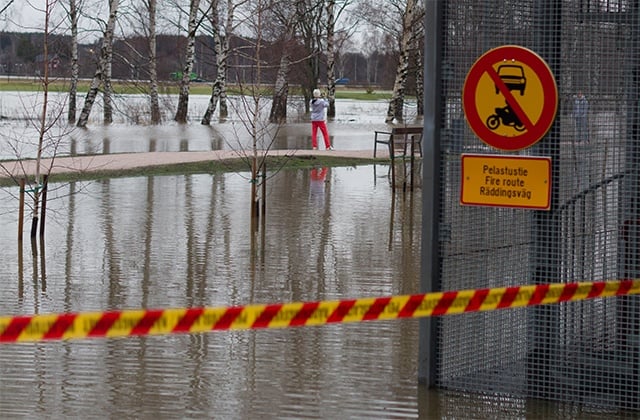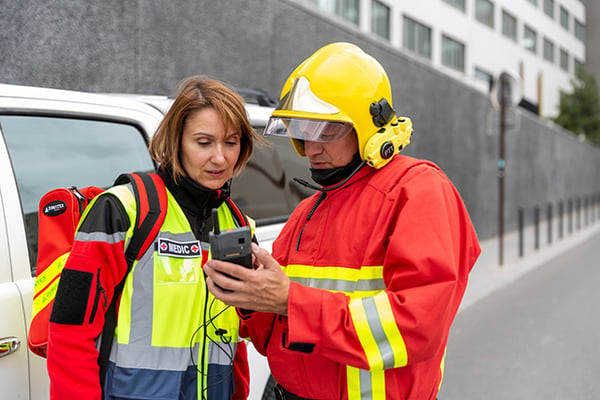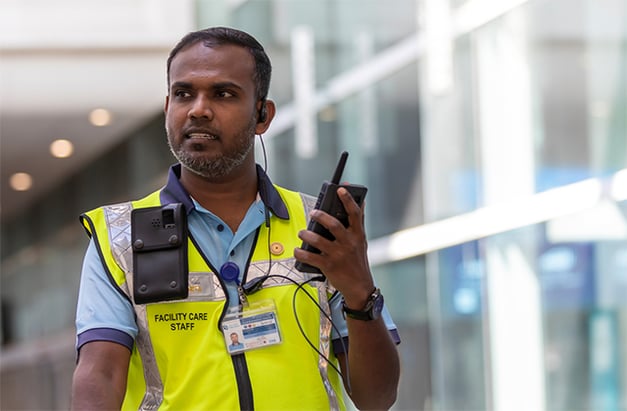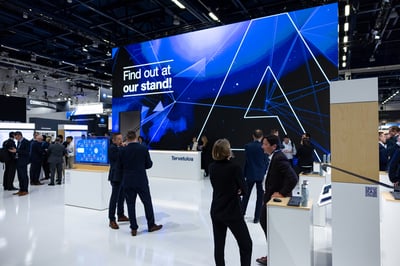Critical organizations need total security for their professional communications. In addition, it is vital to ensure security in other areas. The following are seven strategies of communication security that need to be used so that operations do not become compromised.
1 - Physical security
The physical security of a communication network is the responsibility of the network operator. The operator must ensure that the critical network elements are protected against the normal rigors of nature, against exceptional environmental conditions and against physical attack. Alarm systems must be in perfect working order, allowing as fast a response to a situation as possible.

Network elements must be physically protected against exceptional environmental conditions.
And if several communication networks are in use – such as in hybrid networks – every one of them must have its physical security in control.
2 - Network elements and architecture
A large part of network security is determined at the planning stage, when the network setup and topology is decided, and even earlier, when its system software is designed.
This strategy must include the following:
- The hardware - servers and base stations, for example – must have an uninterrupted power supply.
- There has to be adequate redundancy in place in the network.
- The communication network should consist of autonomous areas. This way, losing one part would not affect the other parts of the network.
- The network must also have enough capacity to serve its users.
Handpicked related content –
A hybrid network means that the narrowband network (for example TETRA or Tetrapol) is complemented by a dedicated broadband network and/or by commercial 4G/5G networks. In the commercial part of the hybrid network, the mobile network operator MNO provides the radio access services, so the capacity for communications is no longer a single operator’s responsibility.
Yet, users need reliable, first-class services. How can you control the service quality in a hybrid network which uses the services of a commercial MNO? See the answer in the "Why service quality is something to think about today" white paper:
3 - Communication services
The services provided by the communication network contribute to the overall security, of course. Key services include prioritization mechanisms: these help guarantee that critical users can continue their communications in all circumstances.
The network must obviously have features that prevent wrong people from accessing the communications by eavesdropping or with a stolen or pirate device, for example. It is important to have the possibility to disable user devices that have been lost or stolen to ensure uninterrupted availability of service for mission critical users.
Discrete listening, ambience listening and jamming detection are further special security functions that today’s critical communications users have learnt to appreciate.
4 - Operation and maintenance
Operation and maintenance of the networks is another key to security. The routines and systems must be well thought out and established, and when maintenance is needed, handling them without down time becomes important.
Network upgrades are another consideration. The latest versions often have new features and functions to improve safety and security, and the operator must manage system upgrades without compromising security in a live network.
The operator of a private network may be a separate organization or one of the organizations who also use the network. It is vital that the operator’s personnel cannot access the information that is internal to the user organizations. When there is proper security in place in a system, those who manage the network technically cannot see organization-specific data – for example, the names of the groups, let alone the names of the users.
Ensuring similar privacy in a hybrid network is more complicated. After all, a commercial mobile network operator MNO can decide where to store and how to process user-specific data. The risks related to this can be managed by adopting a mission-critical Service Operator approach.
Hand-picked related content –
How to adopt broadband while maintaining control - and why is it so important to maintain it? Download "Why Secure MVNO is your next smart move" white paper and you will have the answers.
5 - Competence and preparedness
Even the safest network will become vulnerable if the users do not have adequate skills. Training must be comprehensive and there must be a well thought out organization in place.

And although the routine use of the system can be learned quickly, personnel must also be prepared for exceptional situations and major incidents. Volunteer organizations may be called on to participate in operations and they too must be trained and prepared to take on their duties.
6 - Personnel safety
For people working in mission critical tasks, staying in touch is the key to personnel safety.

Reliable, available communications safeguard the personnel. In addition, user devices should support special safety features, such as the emergency call. Other examples of functions that could save someone’s life include the following:
- End-to-end encryption, the ultimate protection from eavesdroppers.
- A “man-down” feature which will alert backup if the user’s device stops moving or stays horizontal too long - the Lifeguard feature, for example
- A feature which can tell the user where and how far colleagues are at the moment - like the Where Are You feature, or an app like SenTAct which can provide a dispatcher accurate and real-time location data for the device, both indoors and outdoors, and without the need for GPS.

7 - Information security
When information security is mentioned, passwords and encryption are among the first things that come to mind. Encryption is indeed an important element of security, but at least as important is to be sure that the encryption keys are administered in the safest possible manner.
Loss of confidential data or data corruption are risks related to data inside user devices or accessible through them. That is why the user devices themselves must also contain safeguards to provide high confidentiality and integrity.
For example, consumer smartphones as such are notoriously open to attack from people seeking to use the data they contain to gain access to the owner’s details, passwords and other confidential information. Because of these risks, adopting smartphones into use in professional organizations should involve rigorous security planning.
Handpicked white paper: "How to manage smartphone risks for professional users"
Security is the sum of all elements
A mobile network’s security depends on a wide range of measures – not just its availability, not just end-to-end encryption, nor any other single aspect. This is why the pros have learned to use these seven strategies.
Only when all strategies are in use can one trust that the communication services that the network delivers are secure. Only then can the network be shock-proof such as the ones described in the white paper: "Shock-proof networks - How professional radio communication helps tackle extreme circumstances ".
You may also be interested in this ultimate guide to hybrid solutions.






